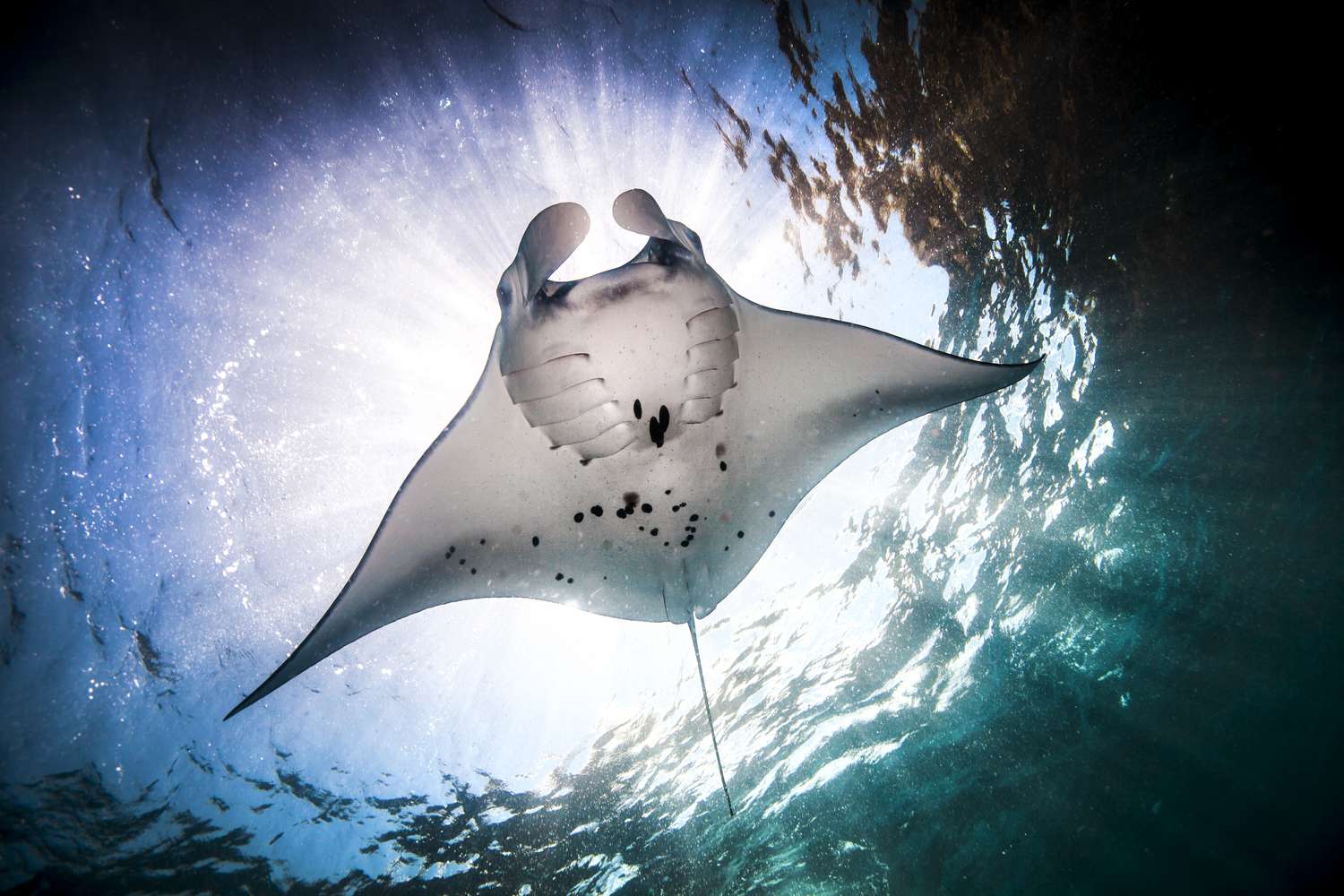Dive into the extraordinary world of manta rays! Get ready for some mind-boggling facts about these gentle giants. We’ll explore why they’re called “sea butterflies,” how they use their massive wings, and why they’re so important for our oceans. Let’s discover the many wonders of these mesmerizing creatures.
Fun Facts About Manta Rays
Manta rays are like the ocean’s gentle giants – they’re big, beautiful, and surprisingly graceful! Let’s dive in and uncover some fascinating facts about these mesmerizing creatures.
They’re Huge, But Don’t Worry, They’re Harmless
Imagine a fish with the wingspan of a small airplane! Manta rays can grow up to a whopping 23 feet across, making them the biggest rays in the world. But don’t let their size intimidate you – they’re actually gentle filter feeders. Instead of hunting down prey, they cruise through the water, mouths wide open, scooping up tiny plankton and krill.
Built for Speed and Style
Have you ever watched a manta ray glide through the water? It’s almost like they’re flying! Their giant pectoral fins act like wings, propelling them forward with effortless grace. And talk about maneuverability! They can make sharp turns and even leap out of the water, putting on quite the acrobatic show.
Masters of Disguise
One of the coolest things about manta rays is their ability to change color. They can blend in with their surroundings, making it tough for predators to spot them. Think deep blues, grayish browns, and even intricate patterns – they’re like underwater chameleons! This camouflage also helps them sneak up on their unsuspecting prey.
Super Senses for an Underwater World
Manta rays have some seriously impressive senses that help them navigate the vast ocean. They have electroreceptors, which allow them to detect the faint electrical fields given off by other animals. This is super helpful for finding food, especially in murky water. And their eyesight isn’t too shabby either – they can see pretty well, even in low light conditions.
Social Butterflies of the Sea
You might be surprised to learn that manta rays are quite social. They often gather in large groups, sometimes hundreds strong, especially when it’s time to feed. And when it comes to courtship, things get pretty elaborate. Imagine graceful dances and synchronized swimming – they definitely know how to put on a show! Some experts believe that manta rays might even form long-term bonds, which is pretty amazing for fish!
Facing Threats, Needing Our Help
Sadly, despite their size and resilience, manta rays are facing some serious challenges. Overfishing is a major threat, as their gills are highly valued in some cultures. Habitat destruction, pollution, and climate change are also taking a toll on their populations. The good news is that conservation efforts are underway to protect these magnificent creatures. By learning more about them and supporting sustainable practices, we can all play a part in ensuring that manta rays continue to grace our oceans for generations to come.
What Makes Manta Rays Unique?
Manta rays are undoubtedly fascinating! They are the biggest rays out there, but their uniqueness extends far beyond their size. Imagine these massive creatures, with their wingspans stretching out longer than a car, gracefully gliding through the ocean. Those triangular fins aren’t just for show – they’re like underwater wings, propelling these gentle giants through the water with mesmerizing grace.
And speaking of mesmerizing, have you ever seen a manta ray’s face? Their broad heads and those unique gill slits on their underside make them look unlike any other creature in the ocean. Some people even call them “devil rays” because of the horn-like shape of their cephalic fins, but don’t let that fool you – they’re far from devilish!
What’s truly incredible about manta rays is their intelligence. They have the biggest brains (compared to their body size) of any fish we know of, and scientists are constantly discovering new things about their complex cognitive abilities. It’s like they have this whole other level of thinking going on beneath the surface.
Here’s a closer look at what makes manta rays so special:
| Feature | Description |
|---|---|
| Size | Can reach wingspans up to 23 feet (7 meters), larger than most cars! |
| Appearance | Triangular pectoral fins, broad heads, gill slits on the ventral surface (underside) |
| Intelligence | Largest brain-to-body ratio among fish, capable of complex behaviors |
| Diet | Plankton and small fish |
| Habitat | Tropical and temperate ocean waters around the world |
It’s important to note that research on manta rays is still ongoing. Scientists are constantly learning new things about their behavior, intelligence, and the challenges they face in a changing ocean. While we know a lot about these gentle giants, there’s still much more to discover!
Does a Manta Ray Have Teeth?
It seems strange to think about these graceful giants having teeth, right? After all, they’re not exactly known for chomping and chewing like sharks. But here’s the thing – manta rays do have teeth, though you wouldn’t exactly call them menacing.
Instead of the sharp, pointy teeth we usually picture, a manta ray’s teeth are surprisingly small and square-shaped. And, instead of a mouthful, they only have teeth on their lower jaws. These tiny teeth aren’t much use for biting or tearing. Their main job is to help the manta ray hold onto its food – mostly tiny plankton that they filter from the water. Think of it like a built-in strainer!
Now, things get a little more interesting with some types of manta rays. The reef manta ray, for example, has a few larger teeth on its upper jaw. Scientists believe these bigger teeth help them grab onto prey more effectively, like holding onto a squirmy squid.
Even with these teeth, it’s important to remember that manta rays are gentle filter feeders. They much prefer a mouthful of plankton or small fish over anything bigger. So, while they technically have teeth, they’re definitely not the kind you need to worry about!
Do Manta Rays Love Humans?
We’ve already talked about how intelligent and graceful manta rays are, but what about their feelings towards us? Could these gentle giants actually be capable of something like love for humans?
Well, it’s tricky. Scientists haven’t exactly written a “love dictionary” for sea creatures, so we can’t say for sure. But there are definitely some clues that make you wonder!
Divers and snorkelers often tell stories about manta rays acting super chummy with them. They describe these giant fish playfully swimming alongside them, almost as if they’re happy to hang out. Imagine a friendly puppy in the ocean, that’s kind of the vibe!
Some divers even say that manta rays will circle them or flash what looks like a smile by curling their mouths. It’s almost like they recognize the divers and enjoy their company. Now, that doesn’t necessarily mean it’s love, but it could be a sign of feeling safe and comfortable around humans, which is pretty cool!
But here’s the thing, even if manta rays enjoy our company, they’re still wild animals with their own boundaries. It’s super important to remember that they can become defensive if they feel threatened or scared. Just like you wouldn’t want a stranger getting up in your face, we need to give manta rays their space. The best way to enjoy these magnificent creatures is to admire them from a distance and let them approach us if they choose.
So, do manta rays experience love in the same way humans do? We’re not 100% sure yet. But the more we observe them and study their behavior, the closer we get to understanding the complex inner lives of these fascinating creatures. One thing’s for sure, the possibility of a deep connection between humans and manta rays is an exciting area of ongoing research!
Can a Manta Ray Fly?
Okay, so we know manta rays live in the ocean, right? But they have these HUGE fins that look a lot like wings. And sometimes, they launch themselves right out of the water! It’s a pretty awesome sight. This makes you wonder – are they actually trying to fly?
Let’s be real, manta rays aren’t about to soar through the clouds like birds. They don’t have feathers, and gravity would probably have something to say about a giant fish taking to the sky. But these leaps they do? Scientists call them “breaching,” and they’re still a bit of a mystery.
Here’s what we do know: manta rays are incredibly smart. In fact, their brains are bigger than any other fish! This means they’re capable of learning and even playing. Some scientists believe that breaching could be a way for them to communicate, kind of like a giant underwater “Hey, look at me!”
Others think it might be a way to get rid of pesky parasites or even just a burst of energy. Imagine trying to scratch an itch when you’re that big! A good leap out of the water might do the trick.
The truth is, we’re still learning about these amazing creatures. Each new study gives us more pieces to the puzzle, but the mystery of why manta rays breach remains. One thing’s for sure – their powerful jumps out of the water are a reminder of the incredible diversity and wonder of the ocean.
What Is a Fun Fact About Manta Rays?
Manta rays are basically the geniuses of the fish world! They have this crazy large brain compared to their body size, bigger than any other fish out there. It’s like having a tiny car with a giant engine! This makes them super smart and capable of some pretty amazing things.
Think about it – you don’t get to be that big and graceful without some serious brainpower. Scientists are still trying to figure out exactly how intelligent they are, but some believe they might even be able to recognize themselves in a mirror! That’s right up there with dolphins and some primates!
And they’re not just book smart, they’re street smart too. They use their smarts to navigate the ocean, find food, and even communicate with each other. Imagine, these silent giants gliding through the water, having whole conversations with each other that we can’t even hear!
Speaking of food, even though they look like something out of a scary movie, these gentle giants are actually big softies. They’re filter feeders, which means they eat tiny little creatures called plankton. They basically swim through the water with their mouths open, like a giant filter, and just swallow up all the plankton. It’s kind of like how a whale shark eats, except manta rays are much more graceful about it!
There’s still so much we don’t know about these mysterious creatures. Scientists are constantly making new discoveries about their behaviors, their intelligence, and their role in the ocean ecosystem. One thing’s for sure though – manta rays are a fascinating and important part of our planet, and we’re lucky to share the ocean with them.
What Kills Manta Rays?
So, we’ve talked about what these gentle giants eat, but what eats them? Well, like many creatures in the ocean, manta rays have a few natural predators. Big sharks, especially tiger sharks, and those powerful hunters, killer whales, are probably their biggest threats. Even smaller sharks like cookie-cutter sharks can take bites out of manta rays, though they are more of a nuisance than a deadly threat.
While these predators are a natural part of the ocean, humans are causing a lot of trouble for manta rays too. You see, we’re destroying their homes. When we build things on the coast, pollute the water, or fish too much, it messes up the places where manta rays live and find food.
Then there’s the issue of fishing itself. Sadly, some people hunt manta rays for their gill plates, which are used in some traditional medicines. This trade isn’t always well-regulated and can really hurt manta ray populations.
And as if that wasn’t enough, climate change is adding another layer of stress. As the ocean warms and becomes more acidic, it can disrupt the delicate balance of the manta rays’ world. This can affect their food sources and even make it harder for them to survive.
Scientists are still learning about all the ways climate change impacts manta rays, and it’s a complex issue. But one thing is for sure: we need to learn more about these threats and protect manta rays so they can continue to grace our oceans for generations to come.
How are Manta Rays Different from Other Rays?
So, we’ve been talking about how cool manta rays are, but what exactly makes them stand out from their ray relatives? Well, it’s like comparing a jumbo jet to a sparrow—both are amazing fliers, but they’re on completely different levels.
For starters, think about skeletons. Most rays have skeletons made of bone, just like us. Manta rays? They’re rocking a skeleton made of cartilage. That’s the same bendy stuff in our noses and ears! This cartilage makes them incredibly flexible, helping them glide through the water with those graceful, almost bird-like movements.
And speaking of things that are different, forget the whole “stingray danger” image. You know, that sharp, venomous barb some rays have on their tails? Yeah, manta rays skipped that evolutionary memo. They’re completely harmless to humans, content to cruise the ocean and filter-feed on tiny plankton.
But perhaps the most fascinating difference lies in their brains. Manta rays are basically the geniuses of the ray world. They have the largest brain-to-body ratio of any fish, and it shows! Scientists are constantly discovering new things about their intelligence, but some observations suggest they might be able to recognize themselves in mirrors, which is a sign of self-awareness that you usually only see in highly intelligent animals like apes and dolphins. There’s even some evidence to suggest they engage in social behaviors, like greeting each other—how cool is that?
We still have a lot to learn about these gentle giants, but one thing’s for sure: manta rays aren’t just different from other rays—they’re truly exceptional creatures.
What Is Unique About How the Manta Ray Eats?
So, we’ve talked about how big manta rays can get, but have you ever wondered how these gentle giants eat? It’s actually pretty cool! Unlike a lot of fish that chase down their food, manta rays are filter feeders. Imagine swimming along with your mouth wide open, scooping up whatever tasty treats the ocean currents bring your way – that’s life for a manta ray!
Their secret weapon? These awesome things called cephalic lobes. Picture two fleshy fins, kind of like arms, extending from their head on either side of their mouth. As they swim, these lobes act like funnels, directing water (and all the yummy plankton and krill) straight into their mouths. It’s like having built-in silverware!
But wait, there’s more! Manta rays are also known for their “bottom feeding”. You guessed it – they glide along the ocean floor, mouths close to the ground, hoovering up plankton and other tiny creatures from the sediment. Talk about multitasking, right? This bottom feeding is actually super important for the ocean because it helps keep things clean.
And get this: using these special feeding methods, manta rays can eat a ton! We’re talking up to 12 times their own body weight in a single day. That’s like you eating a school bus full of food! This just goes to show how important these graceful giants are to keeping the ocean’s ecosystem in balance.
While we know a lot about how manta rays eat, there’s always more to learn. Scientists are still studying exactly what types of plankton they prefer and how their feeding habits change in different parts of the world. It’s amazing to think about all the mysteries still hidden beneath the waves!
Why Can’t You Touch Manta Rays?
We’ve all seen those incredible pictures of people swimming alongside manta rays, these huge, graceful creatures gliding through the water. It almost makes you want to reach out and touch, right? But here’s the thing: as tempting as it might be, touching manta rays is a big no-no. And there are some really important reasons why.
First off, remember that manta rays, as chill as they may seem, are wild animals. That means they’re unpredictable. Imagine someone suddenly reaching out and grabbing you – you’d probably jump back in surprise, right? It’s the same for manta rays. If we startle them by touching them, they could react defensively and hurt themselves, or even accidentally hurt you in the process.
But it’s not just about sudden movements. Our hands, even when we think they’re clean, carry tons of tiny bacteria and chemicals. These are things that our bodies are used to, but they can be really harmful to a manta ray’s sensitive skin. Think of it like getting something irritating in your eye – it’s uncomfortable for us, but for a manta ray, these substances can cause infections and other health problems.
Speaking of sensitive, manta rays have this amazing protective layer of slime covering their bodies. It sounds kinda gross, but this slime is super important. It helps them swim smoothly and acts like a shield against bacteria in the water. When we touch them, we risk rubbing off this slime, leaving them vulnerable to infections and making it harder for them to move through the water.
Finally, and this is a big one, respecting a manta ray’s space is crucial for their survival. These animals are already facing threats like pollution and fishing, and stressing them out by getting too close doesn’t help. By observing them from a distance, we show them respect and contribute to the efforts to protect these amazing creatures.
So, the next time you see a picture of someone cozying up to a manta ray, remember that it’s not actually good for the animal. The best way to appreciate these gentle giants is to admire them from afar, letting them swim free and continue their important role in the ocean.
What Is Unique About Stingrays?
Picking up where we left off, let’s delve deeper into what makes stingrays truly stand out in the vast ocean. We’ve already touched upon their venomous tail spines, but there’s so much more to these captivating creatures than meets the eye.
Their body shape is truly one-of-a-kind. Imagine a flat, disc-like figure, almost as if someone took a ray and squished it from top to bottom. That’s a stingray for you! This unique shape isn’t just for looks, it’s perfectly designed for their bottom-dwelling lifestyle, allowing them to glide effortlessly across the seabed.
Speaking of the seabed, that’s where you’ll most likely find these fascinating creatures. They’re masters of disguise, often burying themselves in the sand or mud, making them nearly invisible to unsuspecting prey. But how do they find their next meal if they’re always hiding? That’s where things get even more interesting!
Stingrays have this incredible sixth sense, thanks to special sensors called ampullae of Lorenzini located on their underside. These sensors are like tiny metal detectors, allowing them to sense the faintest electrical fields given off by other animals hiding in the sand. Talk about having an advantage!
Now, you might be thinking all stingrays look alike, but you’d be surprised! The stingray family is incredibly diverse, with over 200 different species, each boasting its own unique look. Some are tiny, like the Dwarf Stingray, barely bigger than your hand, while others, like the Giant Stingray, can grow to be absolutely massive, as big as a car!
And don’t let their stealthy hunting tactics fool you, stingrays can be both predator and prey. While they mostly munch on smaller creatures like mollusks, crustaceans, and small fish, larger stingrays have been known to go after bigger game, including bony fish and even sharks! But, they also need to watch their backs, as larger sharks and some marine mammals consider them a tasty treat.
Sadly, despite their impressive adaptations, many stingray populations are facing growing threats. Overfishing is a major concern, as is habitat destruction and pollution. Some species are even considered vulnerable or endangered.
Scientists are hard at work studying these incredible creatures, trying to understand them better and find ways to protect them. There’s still so much we’re learning about their behaviors, their complex life cycles, and the specific threats they face in different parts of the world.
One thing’s for sure, though. Stingrays are a vital part of the marine ecosystem, and their unique characteristics continue to fascinate and inspire awe in those lucky enough to encounter them.











